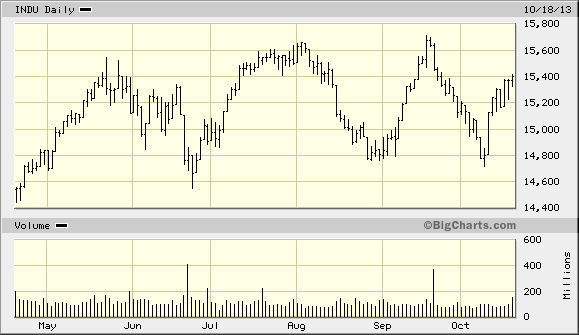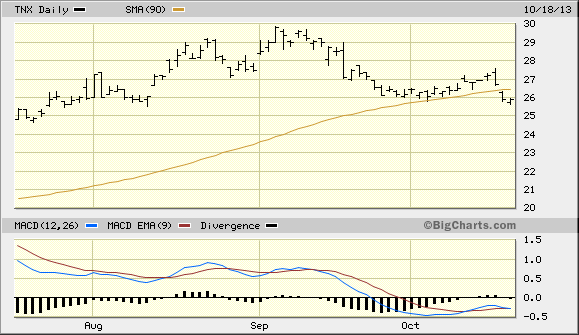Despite its intent to boost asset prices and restore the economy, the Federal Reserve has run into a major obstacle in achieving that goal. This obstacle is serving as a reminder that ultimately the long-term natural cycles of inflation and deflation govern the market and that intervention will usually fail.
That major factor that is engineering the Fed’s eventual defeat is the 10-year Treasury Yield Index (TNX). The rally in Treasury yields from May through September took a lot of steam out of the financial market. The industrial stocks were heavily affected by rising rates as can be seen by the volatile performance of the Dow Jones Industrial Average (below). The reason is that the industrial sector is much more sensitive to changes in interest rates than the tech sector.
The reason why rising interest rates are a potentially serious problem for the economy – as well as a stumbling block for stocks – is explained by Chirantan Basu of Zacks: “Rising yields lead to higher mortgage interest rates…. Higher mortgage interest rates mean higher monthly mortgage payments, which slows down the real estate market as home buyers put off buying new homes or upgrading to larger homes. This drop in demand could depress home resale values, which leads to a drop in household net worth. People feel poorer and less optimistic about the economy, which usually means they spend less on non-essential items.”
Some economists are trying to underplay the effects of rising Treasury by claiming higher yields reflect a stronger economy. While this may true in normal cases, the present case isn’t one of them. Treasury yields started rising soon after the Fed telegraphed its intention to begin tapering QE. Since household borrowing for consumption is the lifeblood of developed economies like the U.S., higher rates are a major point of concern and can’t be underestimated. Rising yields are also the point where the bond market starts to influence and limit U.S. central bank balance sheet expansion due to the increased cost of debt.
Another point worth discussing is that while rising yields may have reflected an improving economy in the “old days” before widespread globalization, the relationship between yields and economic performance is much more complex today. Alen Mattich, writing in The Wall Street Journal, observed that rising Treasury bond yields increase yields across other sovereign debt markets, thereby tying the hands of central bankers. He points out that Bank of England Governor Mark Carney recently made clear that rising U.S. yields were an unwelcome complication for the U.K. economy.
“Unfortunately,” writes Mattich, “other central bankers will find it hard to battle against U.S. headwinds, if only because by trying to keep downward pressure on domestic interest rates, they also run the risk of triggering a currency crisis.”
In recent weeks I’ve mentioned the importance of the 90-day moving average with regard to the Treasury Yield Index. In recent months pullbacks in TNX always found support somewhere above the 90-day MA, including most recently in early October. On Oct. 17, however, TNX broke decisively under the 90-day MA as you can see here. This indicates that the Treasury yield has lost much of its former upside momentum and is now weaker than it was this summer. This in turn should take some of the pressure off equities and make it easier for stocks to rally in the near term.
My best “guesstimate” in terms of potential downside for TNX is that the index should decline no further than approximately the 25.00 level as shown in the above chart. I’m guessing we’ll start to see support becoming established for TNX in the next few weeks yields grind out a lateral trading range. In other words, despite the recent weakness we may not have seen the end of “high” yields.
Another factor working against the Fed’s attempt at creating asset price inflation is the proverbial cockroach in the casserole, namely the anticipated end to QE3. For months investors have nervously awaited the Fed’s official announcement as to when quantitative easing will finally be “tapered.” The Fed has been sly with its handling of this issue, first getting investors used to the idea of the coming end of QE, then surprising everyone by announcing its continuation. This tactic can be interpreted as a form of financial market engineering in itself, although that’s beyond the scope of this commentary.
Even if QE continues into 2014, consumers, mortgage holders and businesses will continue to act as if the end is imminent. As Ramesh Ponnuru has pointed out, “When the Fed creates an impression about future spending levels, it affects the spending that people undertake today in anticipation of that future. So when the Fed suggests that it will pursue a tighter money policy in the future, it is effectively tightening money in the present.”
The point is that the gorilla is out of the cage and investors know that QE’s days are numbered.
- English (UK)
- English (India)
- English (Canada)
- English (Australia)
- English (South Africa)
- English (Philippines)
- English (Nigeria)
- Deutsch
- Español (España)
- Español (México)
- Français
- Italiano
- Nederlands
- Português (Portugal)
- Polski
- Português (Brasil)
- Русский
- Türkçe
- العربية
- Ελληνικά
- Svenska
- Suomi
- עברית
- 日本語
- 한국어
- 简体中文
- 繁體中文
- Bahasa Indonesia
- Bahasa Melayu
- ไทย
- Tiếng Việt
- हिंदी
Why The Fed Will Fail, The Cycles Prevail
Published 10/20/2013, 05:09 AM
Updated 07/09/2023, 06:31 AM
Why The Fed Will Fail, The Cycles Prevail
Latest comments
Loading next article…
Install Our App
Risk Disclosure: Trading in financial instruments and/or cryptocurrencies involves high risks including the risk of losing some, or all, of your investment amount, and may not be suitable for all investors. Prices of cryptocurrencies are extremely volatile and may be affected by external factors such as financial, regulatory or political events. Trading on margin increases the financial risks.
Before deciding to trade in financial instrument or cryptocurrencies you should be fully informed of the risks and costs associated with trading the financial markets, carefully consider your investment objectives, level of experience, and risk appetite, and seek professional advice where needed.
Fusion Media would like to remind you that the data contained in this website is not necessarily real-time nor accurate. The data and prices on the website are not necessarily provided by any market or exchange, but may be provided by market makers, and so prices may not be accurate and may differ from the actual price at any given market, meaning prices are indicative and not appropriate for trading purposes. Fusion Media and any provider of the data contained in this website will not accept liability for any loss or damage as a result of your trading, or your reliance on the information contained within this website.
It is prohibited to use, store, reproduce, display, modify, transmit or distribute the data contained in this website without the explicit prior written permission of Fusion Media and/or the data provider. All intellectual property rights are reserved by the providers and/or the exchange providing the data contained in this website.
Fusion Media may be compensated by the advertisers that appear on the website, based on your interaction with the advertisements or advertisers.
Before deciding to trade in financial instrument or cryptocurrencies you should be fully informed of the risks and costs associated with trading the financial markets, carefully consider your investment objectives, level of experience, and risk appetite, and seek professional advice where needed.
Fusion Media would like to remind you that the data contained in this website is not necessarily real-time nor accurate. The data and prices on the website are not necessarily provided by any market or exchange, but may be provided by market makers, and so prices may not be accurate and may differ from the actual price at any given market, meaning prices are indicative and not appropriate for trading purposes. Fusion Media and any provider of the data contained in this website will not accept liability for any loss or damage as a result of your trading, or your reliance on the information contained within this website.
It is prohibited to use, store, reproduce, display, modify, transmit or distribute the data contained in this website without the explicit prior written permission of Fusion Media and/or the data provider. All intellectual property rights are reserved by the providers and/or the exchange providing the data contained in this website.
Fusion Media may be compensated by the advertisers that appear on the website, based on your interaction with the advertisements or advertisers.
© 2007-2025 - Fusion Media Limited. All Rights Reserved.
